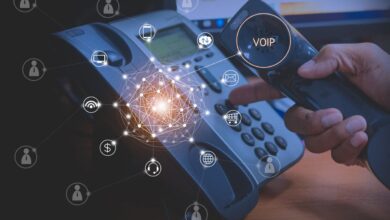Cutting the Cord for Mobile Phones A New Era
Cutting the cord for mobile phones is becoming increasingly popular, with many people opting for alternative communication methods. This trend is driven by factors such as affordability, the rise of other communication options, and environmental concerns. Young adults, families, and professionals are all being affected by this shift, as people explore the reasons behind their decision to ditch their phones.
This blog post delves into the reasons behind this growing trend, considering the long-term implications for the mobile phone industry, and explores the alternatives and practical considerations involved.
The rise of communication alternatives like landlines, VoIP, and messaging apps is fueling this shift. This change offers a fascinating look at how people are adapting to a more connected, yet mobile-free lifestyle. The financial advantages and disadvantages of these alternative methods are also considered, alongside a step-by-step guide to transitioning to a mobile-free lifestyle.
Understanding the Trend
The “cord-cutting” phenomenon, once a niche interest, is rapidly gaining traction as a mainstream lifestyle choice. People are increasingly ditching traditional mobile phone plans in favor of alternative communication methods. This shift reflects a broader societal trend toward greater control over personal expenses and a growing awareness of environmental impact.The rise of affordable, reliable, and widely accessible communication platforms like VoIP, messaging apps, and video conferencing has made the need for a traditional mobile contract less compelling for many.
This has significantly impacted how individuals and families approach communication.
Factors Driving the Trend
The desire to cut the cord is driven by a confluence of factors, including cost savings, access to alternative communication options, and environmental consciousness.
- Affordability: Mobile phone plans often represent a significant recurring expense, particularly for families or individuals with limited budgets. The ability to leverage free or low-cost communication options, such as using Wi-Fi calling or relying on messaging apps, significantly reduces this burden.
- Access to Alternative Communication Options: The proliferation of VoIP services, messaging apps, and video conferencing platforms has created robust alternatives to traditional mobile phone plans. These platforms offer comparable functionality at a fraction of the cost, making cutting the cord a practical choice.
- Environmental Concerns: The production and disposal of mobile phones contribute to electronic waste (e-waste). Individuals increasingly consider the environmental impact of their consumption choices. Choosing to cut the cord can be a small step toward a more sustainable lifestyle.
Demographics Affected
The trend of cutting the cord is not limited to any single demographic. It affects young adults, families, and professionals alike.
- Young Adults: Often seeking cost-effective solutions and new communication methods, young adults frequently find value in alternative platforms like WhatsApp and Signal.
- Families: Families are particularly drawn to cost savings, and group messaging and video calls through apps can be a more affordable and convenient option than individual mobile plans.
- Professionals: Professionals often utilize a blend of personal and work communication methods. They are receptive to cost-effective communication tools that facilitate both personal and professional needs.
Reasons for Choosing to Cut the Cord
People choose to cut the cord for a variety of reasons, ranging from financial considerations to environmental concerns.
- Cost Savings: This is often the primary driver. Cutting the cord can lead to substantial monthly savings, which can be reinvested or used to address other financial needs.
- Increased Control Over Expenses: Individuals who cut the cord gain greater control over their communication budget. They can avoid unexpected overages or hidden fees, enabling better financial planning.
- Environmental Consciousness: Choosing not to subscribe to a mobile plan can reduce the amount of electronic waste generated. This aligns with a growing concern for environmental sustainability.
Long-Term Implications
The trend of cutting the cord will likely reshape the mobile phone industry in the long term.
| Factor | Demographic | Reason | Implication |
|---|---|---|---|
| Affordability | Families | Seeking cost-effective communication | Increased demand for affordable VoIP services and messaging apps. |
| Alternative Communication Options | Young Adults | Attracted to new communication methods | Shift in mobile phone usage patterns, leading to a potential decrease in traditional contract subscriptions. |
| Environmental Concerns | Professionals | Seeking sustainable consumption choices | Potential for new business models centered around environmentally conscious communication technologies. |
| Cost Savings | All Demographics | Desire for better control over expenses | Continued pressure on mobile carriers to offer competitive and transparent pricing. |
Alternatives and Solutions
Cutting the cord from mobile phones opens up a world of communication possibilities beyond the familiar. This freedom allows individuals to tailor their communication strategies to their unique needs and priorities, rather than being bound to a single device. Embracing alternatives often leads to more intentional communication and a greater appreciation for the various methods available.The shift away from mobile dependence requires exploring diverse communication options.
Understanding the strengths and weaknesses of each method is crucial in crafting a personalized communication system. Financial implications, effectiveness, and personal preferences all play a vital role in the transition. This section details various alternatives and their practical applications.
Communication Alternatives
Different communication alternatives cater to diverse needs and preferences. Landlines, VoIP services, messaging apps, and even in-person interactions can effectively replace the reliance on mobile phones. Choosing the right blend of these methods ensures seamless communication without the limitations of a mobile phone.
Finally ditching those bulky chargers for mobile phones feels liberating, right? Imagine a future where we could cut the cord for PCs too, maybe with innovative power sources like those being explored with fuel cells for PCs – are we closer to that future? fuel cells for pcs closer or come on. This would be a major leap forward, and perhaps, the next big step in our pursuit of cord-free tech for everything from phones to laptops.
- Landlines provide a reliable, traditional form of communication. They offer clear audio quality and are particularly useful for those needing a consistent, direct connection.
- VoIP (Voice over Internet Protocol) services offer a cost-effective alternative to traditional landlines, allowing calls over the internet. This method can be more economical, especially for international calls.
- Messaging apps have become a crucial part of modern communication. Apps like WhatsApp, Telegram, and others allow instant messaging, voice calls, and video calls. Their widespread use makes them a valuable tool for staying connected with friends and family.
- In-person interactions are a cornerstone of meaningful relationships. Face-to-face conversations are essential for building trust, nurturing connections, and fostering strong personal bonds. The personal touch often cannot be replicated by digital methods.
Comparison of Communication Methods
This table Artikels the comparative advantages and disadvantages of various communication methods, including mobile phones, landlines, VoIP, and messaging apps.
| Feature | Mobile Phone | Landline | VoIP | Messaging App |
|---|---|---|---|---|
| Cost | Variable (depending on plan) | Fixed monthly fee | Variable (depending on plan) | Free (or low cost) for basic usage |
| Accessibility | High (almost everywhere) | High (in most areas) | High (internet access required) | High (internet access required) |
| Call Quality | Generally good | Generally clear | Good, potentially variable depending on internet quality | Variable, depending on internet quality |
| Privacy | Variable (depending on security settings) | Generally high | Variable (depending on security settings) | Variable (depending on security settings) |
| Portability | High | Low | Low (unless portable device used) | Low (unless portable device used) |
Managing Communication Effectively
Maintaining communication without a mobile phone requires a conscious effort to prioritize different methods. A well-organized system using a combination of alternatives can ensure seamless communication.
- Establish a dedicated contact list for each communication method (e.g., landline for family, messaging apps for friends). This prevents confusion and ensures efficient communication.
- Use a calendar or planner to schedule calls and meetings using the chosen communication methods. This ensures that important interactions are not missed.
- Maintain a clear communication strategy. Knowing when and how to use each method will streamline interactions and avoid miscommunication.
Financial Advantages and Disadvantages
Switching to alternative communication methods can lead to significant financial benefits. Landlines and VoIP often provide lower monthly costs than mobile phone plans.
Messaging apps can be a cost-effective way to stay in touch, especially for international communication.
Transitioning to a Mobile-Free Lifestyle
Transitioning to a mobile-free lifestyle involves a phased approach.
- Assess current communication habits. Identify which methods are most crucial and how they can be replaced with alternatives.
- Set realistic goals. Gradually reduce reliance on mobile phones by incorporating alternatives into daily routines.
- Communicate the change to contacts. Inform family and friends about the transition and preferred alternative methods.
- Establish backup plans for emergencies. Ensure that there are ways to contact in case of urgent situations.
Practical Considerations: Cutting The Cord For Mobile Phones

Cutting the cord from mobile phones can be a liberating experience, but it’s crucial to consider the practical implications before taking the plunge. This involves understanding potential challenges and developing effective strategies to manage communication, social interaction, emergencies, and daily tasks without relying on a mobile device. Navigating this transition successfully requires careful planning and proactive solutions.
Emergency Communication
Reliable emergency communication is paramount. Without a mobile phone, alternative methods are necessary. A landline phone, if available, provides a critical fallback. Knowing the location of a reliable neighbor or friend with a working phone can also be essential. For some, a personal emergency beacon or satellite phone is a necessary investment, providing reliable communication in remote areas or during critical situations.
Thinking about ditching my mobile phone contract? It’s a pretty big decision, and the recent news about HP revealing job cut plans in a SEC filing here makes me wonder about the broader implications of these kinds of corporate shifts. Maybe a simpler life, less reliance on constant connection, and a renewed focus on real-world interactions is the key to a better life.
Cutting the cord on mobile phones might be a good thing after all.
- Concern: Accessing emergency services without a mobile phone.
- Solution: Maintaining a landline phone, identifying a trusted contact with a functioning mobile, and potentially investing in a personal emergency beacon or satellite phone.
- Example: A person living in a remote area might need a satellite phone for emergencies.
Maintaining Social Connections
Maintaining social connections without a mobile phone requires proactive planning. Consider utilizing alternative communication methods like email, instant messaging services (that do not require a phone number), and dedicated social media groups or platforms. Regular phone calls, video calls, or in-person meetings are also important.
- Concern: Staying connected with friends and family without constant mobile access.
- Solution: Utilizing alternative communication channels, such as dedicated social media groups, emails, and video calls. Scheduling regular in-person meetings and phone calls.
- Example: Utilizing a dedicated social media group for a book club, or scheduling weekly phone calls with family members.
Managing Business Communications
Business communication strategies need adaptation. Consider using a landline phone for calls, email, and messaging platforms for immediate responses. Using a VoIP service or a business-oriented instant messaging service might also be helpful.
| Concern | Solution | Example |
|---|---|---|
| Maintaining business communication without a mobile phone | Utilizing a landline phone, email, and messaging platforms; explore VoIP services for calls and instant messaging. | A freelancer might use a dedicated landline phone for client calls and email for correspondence. |
Managing Travel and Location Awareness
Traveling without a mobile phone requires alternative methods for tracking location and arranging transportation. Utilizing a GPS-enabled device or relying on printed maps, coupled with sharing your travel plans with someone, can provide peace of mind. Utilizing a dedicated travel app or a shared calendar can be helpful for managing travel details and coordinating with others.
- Concern: Navigating and managing travel details without a mobile phone.
- Solution: Employing GPS-enabled devices, printed maps, sharing travel plans with others, and utilizing a travel app or shared calendar.
- Example: Using a GPS device and a physical map to navigate during a road trip.
Practical Considerations: Summary, Cutting the cord for mobile phones
The decision to cut the cord necessitates careful consideration of various aspects. By anticipating potential challenges and implementing suitable solutions, individuals can effectively manage communication, emergencies, social interactions, business, and travel without relying on a mobile phone.
Technological Advancements
The relentless march of technology is profoundly reshaping communication landscapes, influencing the trend of disconnecting from traditional mobile phone reliance. Advancements in broadband internet access, sophisticated messaging apps, and emerging technologies are offering compelling alternatives, making the “cord-cutting” phenomenon more accessible and appealing. This shift is not merely a trend; it’s a reflection of evolving needs and preferences in the digital age.Broadband internet access has become ubiquitous, providing the crucial infrastructure for alternative communication methods.
Faster speeds and wider availability are making online communication more efficient and convenient than ever before. This fuels the shift away from mobile phones as the primary means of communication.
Broadband Internet Access
Broadband internet access, including high-speed fiber optic networks and 5G cellular data, plays a pivotal role in supporting various communication alternatives to mobile phones. Increased bandwidth enables seamless video calls, high-definition streaming, and instant file sharing, rendering mobile phone calls and texts less essential.
Sophisticated Messaging Apps and Social Media
Modern messaging applications, such as WhatsApp, Telegram, and Signal, have transformed interpersonal communication. These platforms offer features like group chats, video calls, and file sharing, all within a single interface. Social media platforms, with their integrated communication tools, further streamline interactions, replacing the need for separate mobile phone calls. This shift toward integrated communication streams directly reduces reliance on mobile phones.
Emerging Technologies
Emerging technologies, including virtual reality (VR) and augmented reality (AR), hold the potential to fundamentally alter how we communicate. Immersive experiences can foster more engaging and interactive conversations, potentially altering the ways we interact and potentially impacting mobile phone usage.
Improved Alternatives to Mobile Phones
Technological advancements have significantly enhanced the alternatives to mobile phones. Video conferencing tools, for instance, have evolved from low-resolution, cumbersome interfaces to high-definition, user-friendly platforms. This enhanced user experience makes alternatives to mobile phones more attractive and less cumbersome.
Timeline of Communication Technology Evolution
| Year | Technology | Impact on Mobile Phone Usage |
|---|---|---|
| 1990s | Early mobile phones | Mobile phones become the primary communication device, increasing reliance. |
| 2000s | SMS, internet access via mobile | Mobile phones gain additional functionalities, increasing reliance, but alternatives begin to emerge. |
| 2010s | Smartphones, social media, video conferencing | Mobile phones become more versatile, but the rise of alternatives (social media, messaging apps) reduces reliance on traditional calls. |
| 2020s | 5G, VR/AR, AI-powered communication tools | Enhanced communication alternatives emerge, offering greater immersion and convenience, further reducing the need for mobile phones. |
These technological shifts illustrate the ongoing evolution of communication, with the trend of cutting the cord being significantly influenced by the availability and advancement of communication technologies. This trend will likely continue as emerging technologies become more integrated into our daily lives.
Environmental Impact

The relentless rise of mobile technology has undeniably transformed communication, but at what cost to the environment? From the raw materials extracted from the earth to the final disposal of discarded devices, the entire lifecycle of a mobile phone leaves a considerable environmental footprint. Understanding this impact is crucial for making informed choices about our communication habits and fostering a more sustainable future.The production of mobile phones relies heavily on the extraction of rare earth minerals and other metals, often sourced from ecologically sensitive regions.
These processes contribute to deforestation, water pollution, and habitat destruction. Furthermore, the manufacturing process itself consumes vast amounts of energy and generates substantial waste. The disposal of outdated phones, often ending up in landfills or improperly managed recycling facilities, exacerbates the problem, releasing harmful toxins into the environment and contributing to e-waste.
Environmental Impact of Mobile Phone Production
The production of mobile phones, from mining raw materials to assembling components, involves a complex web of environmental concerns. The extraction of rare earth minerals, a critical component in many mobile phone technologies, can cause significant environmental damage. This includes deforestation, soil erosion, water contamination, and disruption of ecosystems. The manufacturing process, with its energy-intensive operations and reliance on fossil fuels, also contributes to greenhouse gas emissions.
Furthermore, improper waste management during the production process leads to pollution and contamination of surrounding environments.
Environmental Impact of Mobile Phone Disposal
The disposal of outdated mobile phones presents a significant environmental challenge. Landfilling discarded phones leads to the leaching of harmful chemicals into the soil and groundwater. Improper recycling can release toxic substances into the air and water. The problem is further compounded by the rapid obsolescence of mobile phone technology, leading to a continuous stream of electronic waste.
This escalating e-waste problem necessitates the development of more sustainable disposal and recycling methods.
Potential Environmental Benefits of Cutting the Cord
Cutting the cord, in the context of mobile phones, implies a shift towards alternative communication methods. This shift can offer several potential environmental benefits. Reduced demand for new mobile phones translates to lower extraction of raw materials and less energy consumption in production. Decreased reliance on mobile phones might also lower e-waste generation.
Comparison of Environmental Footprints
Comparing the environmental footprint of mobile phones to alternative communication methods is essential for understanding the potential benefits of “cord cutting.” Alternative communication methods, such as landlines, messaging apps, and video conferencing, often have lower environmental impacts compared to mobile phones. They require less energy and resources for production and disposal.
Eco-Friendly Alternatives to Mobile Phones
Numerous eco-friendly alternatives to mobile phones exist. Consider using landlines for basic communication, relying on messaging apps for digital correspondence, or leveraging video conferencing for more complex interactions. These alternatives reduce reliance on the resource-intensive production and disposal processes associated with mobile phones.
Role of Sustainable Practices in the Communication Industry
The communication industry plays a pivotal role in shaping our environmental future. Adopting sustainable practices, such as using recycled materials in manufacturing, implementing energy-efficient production processes, and developing eco-friendly product designs, can minimize the environmental impact of mobile phones and other communication devices.
Cutting the cord on mobile phones isn’t just about ditching the monthly bill; it’s also about re-evaluating how we consume entertainment. Think about the parallel with music and film downloads – music film and the price of downloading highlights how the cost of access to content can influence our choices. Ultimately, cutting the cord is about finding a balance between convenience and control over our digital consumption.
Table Comparing Environmental Impact of Communication Methods
| Communication Method | Material Extraction | Energy Consumption | Waste Generation | Environmental Impact Score (1-10, 10 being highest) |
|---|---|---|---|---|
| Mobile Phone | High | High | High | 9 |
| Landline | Low | Low | Low | 2 |
| Messaging Apps | Very Low | Very Low | Very Low | 1 |
| Video Conferencing | Very Low | Low | Low | 2 |
Note: The Environmental Impact Score is a simplified representation and does not account for all environmental factors.
Social and Cultural Implications
The shift away from constant mobile phone connectivity, often termed “cutting the cord,” is profoundly altering social and cultural landscapes. This trend, fueled by a desire for greater digital detachment and a growing awareness of the impact of constant screen time, is not simply a technological change; it’s a social evolution. It necessitates a reevaluation of how we interact, build relationships, and perceive privacy in the modern world.The “cord-cutting” phenomenon is not uniform; individual motivations and experiences vary significantly.
Some individuals seek to reclaim control over their time and mental well-being, while others are driven by environmental or financial concerns. Understanding these diverse motivations is key to comprehending the broader social and cultural impact of this trend.
Social Interactions and Relationships
The shift away from constant mobile phone connectivity is reshaping social interactions. Face-to-face communication is regaining prominence, fostering deeper connections and a greater appreciation for the present moment. However, this change also presents challenges. Some individuals may experience social isolation or feel excluded from certain social circles that heavily rely on mobile communication platforms. Maintaining strong relationships requires conscious effort to balance digital and physical interactions.
Impact on Privacy and Security
The decision to cut the cord can significantly affect individual privacy and security. A reduced reliance on mobile phones, while potentially offering more privacy from targeted advertising and data collection, can also leave individuals vulnerable to different types of security risks if not properly managed. For instance, reliance on physical mail and traditional methods of communication might lead to potential security threats, including the risk of theft or loss of important documents.
Strategies for maintaining privacy and security in this evolving digital landscape are essential.
Perspectives on Social Acceptance
The social acceptance of the “cord-cutting” trend varies considerably. Some view it as a positive step toward healthier digital habits, fostering greater self-awareness and improved well-being. Others might perceive it as a rejection of social norms or a sign of a lack of engagement in the modern world. These differing perspectives highlight the complexity of social adaptation to technological change.
Role of Social Media in Shaping Perceptions
Social media plays a crucial role in shaping public perception of mobile phone usage and the “cord-cutting” trend. Platforms often promote constant connectivity and the use of mobile devices for communication and social interaction. Conversely, some social media accounts and content creators are highlighting the benefits of disconnecting and the value of face-to-face interactions, thereby influencing public opinion on this evolving social phenomenon.
Quotes from Cord-Cutters
-
“I felt constantly tethered to my phone. Cutting the cord has been liberating. I now have more time for myself and my family, and I find I connect with them on a deeper level.”
-Sarah M., a recent cord-cutter. -
“I realized how much time I was wasting on my phone. It felt like I was constantly checking for notifications, even when I wasn’t actively using it. Cutting the cord has helped me reclaim my time and focus on things that matter.”
-David R., another cord-cutter. -
“It’s a gradual process. I’m not completely disconnected, but I’ve significantly reduced my phone usage. I’m finding it easier to be present in the moment and to appreciate the simple things.”
-Emily S., a cord-cutter in the process of adjusting.
Final Conclusion
Cutting the cord for mobile phones is more than just a trend; it’s a reflection of evolving communication needs and values. From environmental concerns to the rise of alternative communication methods, this shift is reshaping how we connect with each other and the world around us. The practical considerations and technological advancements involved in this transition are significant, and the long-term implications are far-reaching.
As technology continues to advance, the possibilities for communication beyond mobile phones will undoubtedly expand, potentially creating a more connected yet less reliant future.







